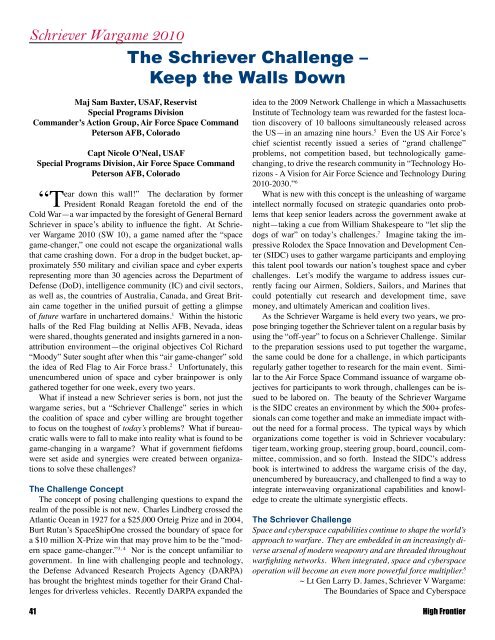Schriever Wargame 2010 - Air Force Space Command
Schriever Wargame 2010 - Air Force Space Command
Schriever Wargame 2010 - Air Force Space Command
Create successful ePaper yourself
Turn your PDF publications into a flip-book with our unique Google optimized e-Paper software.
<strong>Schriever</strong> <strong>Wargame</strong> <strong>2010</strong><br />
The <strong>Schriever</strong> Challenge –<br />
Keep the Walls Down<br />
Maj Sam Baxter, USAF, Reservist<br />
Special Programs Division<br />
<strong>Command</strong>er’s Action Group, <strong>Air</strong> <strong>Force</strong> <strong>Space</strong> <strong>Command</strong><br />
Peterson AFB, Colorado<br />
Capt Nicole O’Neal, USAF<br />
Special Programs Division, <strong>Air</strong> <strong>Force</strong> <strong>Space</strong> <strong>Command</strong><br />
Peterson AFB, Colorado<br />
ear down this wall!” The declaration by former<br />
“TPresident Ronald Reagan foretold the end of the<br />
Cold War—a war impacted by the foresight of General Bernard<br />
<strong>Schriever</strong> in space’s ability to influence the fight. At <strong>Schriever</strong><br />
<strong>Wargame</strong> <strong>2010</strong> (SW 10), a game named after the “space<br />
game-changer,” one could not escape the organizational walls<br />
that came crashing down. For a drop in the budget bucket, approximately<br />
550 military and civilian space and cyber experts<br />
representing more than 30 agencies across the Department of<br />
Defense (DoD), intelligence community (IC) and civil sectors,<br />
as well as, the countries of Australia, Canada, and Great Britain<br />
came together in the unified pursuit of getting a glimpse<br />
of future warfare in unchartered domains. 1 Within the historic<br />
halls of the Red Flag building at Nellis AFB, Nevada, ideas<br />
were shared, thoughts generated and insights garnered in a nonattribution<br />
environment—the original objectives Col Richard<br />
“Moody” Suter sought after when this “air game-changer” sold<br />
the idea of Red Flag to <strong>Air</strong> <strong>Force</strong> brass. 2 Unfortunately, this<br />
unencumbered union of space and cyber brainpower is only<br />
gathered together for one week, every two years.<br />
What if instead a new <strong>Schriever</strong> series is born, not just the<br />
wargame series, but a “<strong>Schriever</strong> Challenge” series in which<br />
the coalition of space and cyber willing are brought together<br />
to focus on the toughest of today’s problems? What if bureaucratic<br />
walls were to fall to make into reality what is found to be<br />
game-changing in a wargame? What if government fiefdoms<br />
were set aside and synergies were created between organizations<br />
to solve these challenges?<br />
The Challenge Concept<br />
The concept of posing challenging questions to expand the<br />
realm of the possible is not new. Charles Lindberg crossed the<br />
Atlantic Ocean in 1927 for a $25,000 Orteig Prize and in 2004,<br />
Burt Rutan’s <strong>Space</strong>ShipOne crossed the boundary of space for<br />
a $10 million X-Prize win that may prove him to be the “modern<br />
space game-changer.” 3, 4 Nor is the concept unfamiliar to<br />
government. In line with challenging people and technology,<br />
the Defense Advanced Research Projects Agency (DARPA)<br />
has brought the brightest minds together for their Grand Challenges<br />
for driverless vehicles. Recently DARPA expanded the<br />
idea to the 2009 Network Challenge in which a Massachusetts<br />
Institute of Technology team was rewarded for the fastest location<br />
discovery of 10 balloons simultaneously released across<br />
the US—in an amazing nine hours. 5 Even the US <strong>Air</strong> <strong>Force</strong>’s<br />
chief scientist recently issued a series of “grand challenge”<br />
problems, not competition based, but technologically gamechanging,<br />
to drive the research community in “Technology Horizons<br />
- A Vision for <strong>Air</strong> <strong>Force</strong> Science and Technology During<br />
<strong>2010</strong>-2030.” 6<br />
What is new with this concept is the unleashing of wargame<br />
intellect normally focused on strategic quandaries onto problems<br />
that keep senior leaders across the government awake at<br />
night—taking a cue from William Shakespeare to “let slip the<br />
dogs of war” on today’s challenges. 7 Imagine taking the impressive<br />
Rolodex the <strong>Space</strong> Innovation and Development Center<br />
(SIDC) uses to gather wargame participants and employing<br />
this talent pool towards our nation’s toughest space and cyber<br />
challenges. Let’s modify the wargame to address issues currently<br />
facing our <strong>Air</strong>men, Soldiers, Sailors, and Marines that<br />
could potentially cut research and development time, save<br />
money, and ultimately American and coalition lives.<br />
As the <strong>Schriever</strong> <strong>Wargame</strong> is held every two years, we propose<br />
bringing together the <strong>Schriever</strong> talent on a regular basis by<br />
using the “off-year” to focus on a <strong>Schriever</strong> Challenge. Similar<br />
to the preparation sessions used to put together the wargame,<br />
the same could be done for a challenge, in which participants<br />
regularly gather together to research for the main event. Similar<br />
to the <strong>Air</strong> <strong>Force</strong> <strong>Space</strong> <strong>Command</strong> issuance of wargame objectives<br />
for participants to work through, challenges can be issued<br />
to be labored on. The beauty of the <strong>Schriever</strong> <strong>Wargame</strong><br />
is the SIDC creates an environment by which the 500+ professionals<br />
can come together and make an immediate impact without<br />
the need for a formal process. The typical ways by which<br />
organizations come together is void in <strong>Schriever</strong> vocabulary:<br />
tiger team, working group, steering group, board, council, committee,<br />
commission, and so forth. Instead the SIDC’s address<br />
book is intertwined to address the wargame crisis of the day,<br />
unencumbered by bureaucracy, and challenged to find a way to<br />
integrate interweaving organizational capabilities and knowledge<br />
to create the ultimate synergistic effects.<br />
The <strong>Schriever</strong> Challenge<br />
<strong>Space</strong> and cyberspace capabilities continue to shape the world’s<br />
approach to warfare. They are embedded in an increasingly diverse<br />
arsenal of modern weaponry and are threaded throughout<br />
warfighting networks. When integrated, space and cyberspace<br />
operation will become an even more powerful force multiplier. 8<br />
~ Lt Gen Larry D. James, <strong>Schriever</strong> V <strong>Wargame</strong>:<br />
The Boundaries of <strong>Space</strong> and Cyberspace<br />
41 High Frontier

















